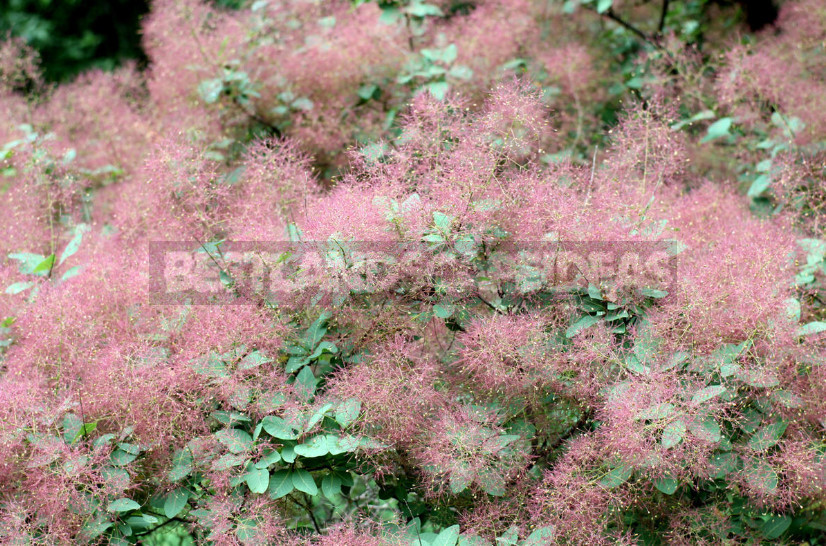
In Europe, with a temperate climate and in the East of North America grows this is not quite an ordinary shrub or small tree. In nature, most often it can be seen on the gravelly slopes, in woodlands and on the edges of oak and pine forests.
Cotinus belongs to the family Anacardiaceae. Only in the genus of 7 species, and they are all deciduous trees or shrubs.
Cotinus coggygria
The most known Cotinus coggygria, it is grown as an ornamental garden plant. In addition, it is used to produce yellow paint. For light clouds of inflorescences, the plant is also called a smoky or wig tree.
Cotinus is a shrub or low tree – no more than 5 m in height, its lush crown has a rounded shape and can be up to 3 m in diameter. It is formed by numerous bare and shiny branches, from the Sunny side acquiring a reddish hue.
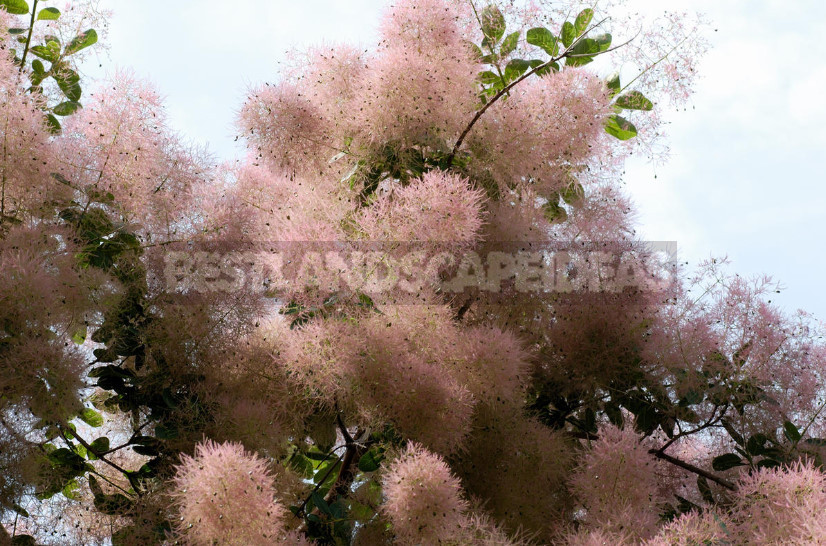
The leaves of the tree are simple, elliptical in shape, size 10×7 cm, leaf blade is smooth on top, slightly pubescent below. Light green in the summer, in the autumn foliage becomes very bright color-yellow-orange, scarlet. Roots Cotinus much branched, located superficially.

But especially Cotinus transformed in the period of flowering and fruiting. By themselves, its flowers are small and nondescript, cream-colored, collected in loose paniculate inflorescences bloom in may. The inflorescence has both female and male flowers, as well as many infertile flowers. Here they do the tree is particularly ornamental.
After flowering their pedicels lengthen, they grow long hairs of reddish or light yellow, and inflorescences are like air, reminiscent of fluffy clouds. Fruitlets-drupe ripen usually in August. Growing in the South Cotinus can bloom several times during the summer season.
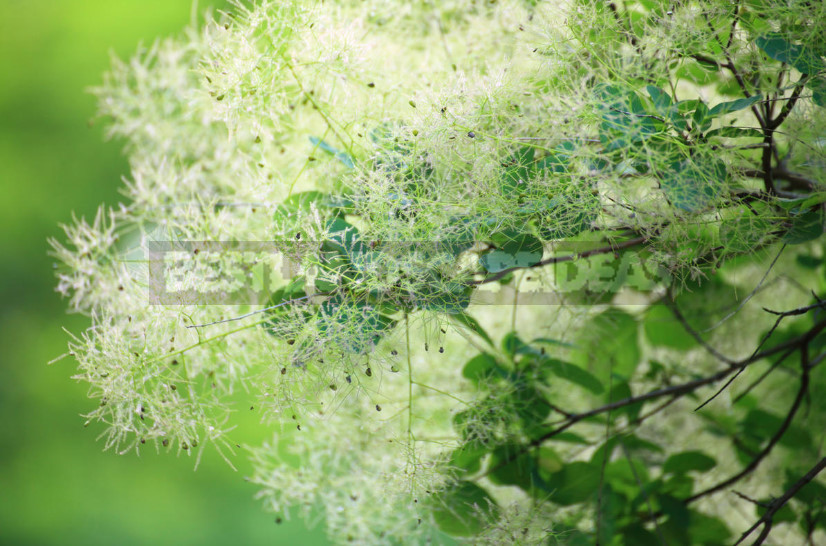
Cotinus prefers Sunny places. In nature, it tolerates the lack of moisture, grows on dry, calcareous soils. Does not tolerate heavy, wet soil. It can rise up to 1200 m above sea level. In areas with severe winters freezes Cotinus, are particularly affected by her new growth, but the recovery is easy, and the Bush regains her beautiful form.
Popular variety
The breeders have selected varieties Cotinus with brightly colored leaves. But they are not as hardy as natural species and can only grow in the southern regions. Fairly stable form ‘Purpureus’ leaves with a beautiful purple color.
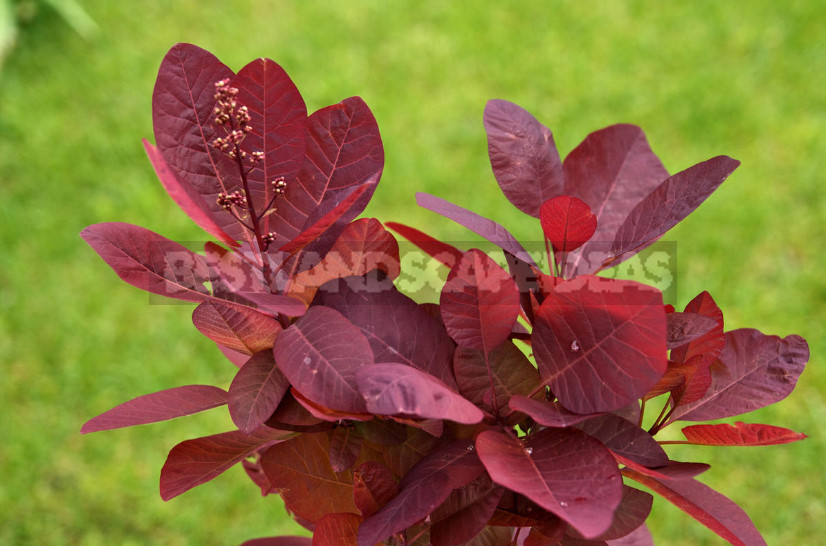
The following varieties are popular among gardeners:
- ‘Royal Purple’
The most common variety is Cotinus. Grows slowly, in height and in diameter reaches no more than 1.5-3 m, takes a rounded shape. The leaves of this variety immediately after blooming are dark red, almost black, in the summer acquire a metallic sheen and slightly less saturated color. In autumn, the plant shows itself in all its glory, dressed in an orange-red outfit. The flowers are red with a silvery sheen.
- ‘Rubrifolius’
This variety usually grows up to 2 m in the southern regions and reaches 3-5. Leaves unusually beautiful rich violet-plum color, in the autumn of their color becomes red.
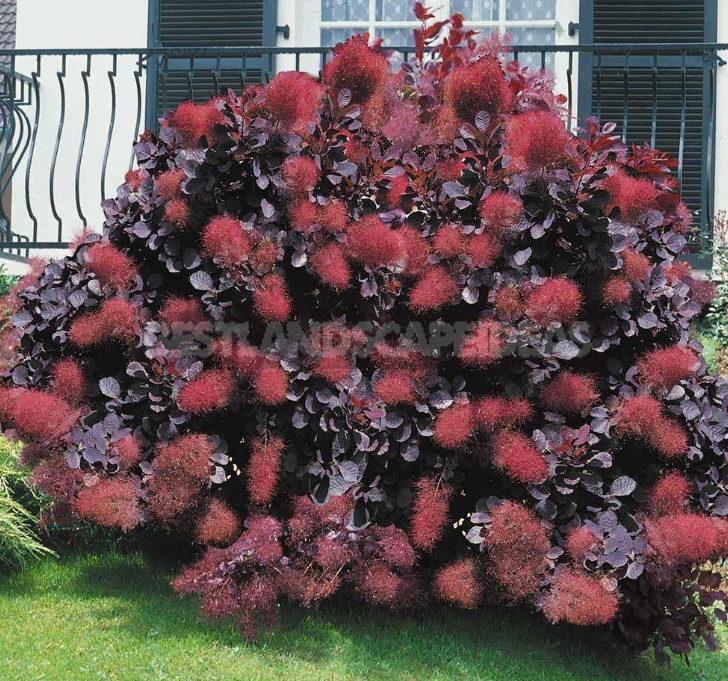
- ‘Grace’
Taller and taller trees-up to 3-5 m tall. The plant is very decorated with large oval leaves, the color of which in the summer of red-purple, in the autumn becomes scarlet. But the main decoration-purple-pink flowers, forming air panicles conical shape.
- ‘Golden Spirit’
The average height of the plant-1.5 – 3 m. its leaves are very decorative at the beginning of its dissolution – with an orange tint on the edges of the leaves and in the center of the veins. Autumn tree becomes even more beautiful: it gradually changes the color of the leaves from light green and orange to rich red, almost purple. Decorate it and clouds of paniculate inflorescences of light yellow color.
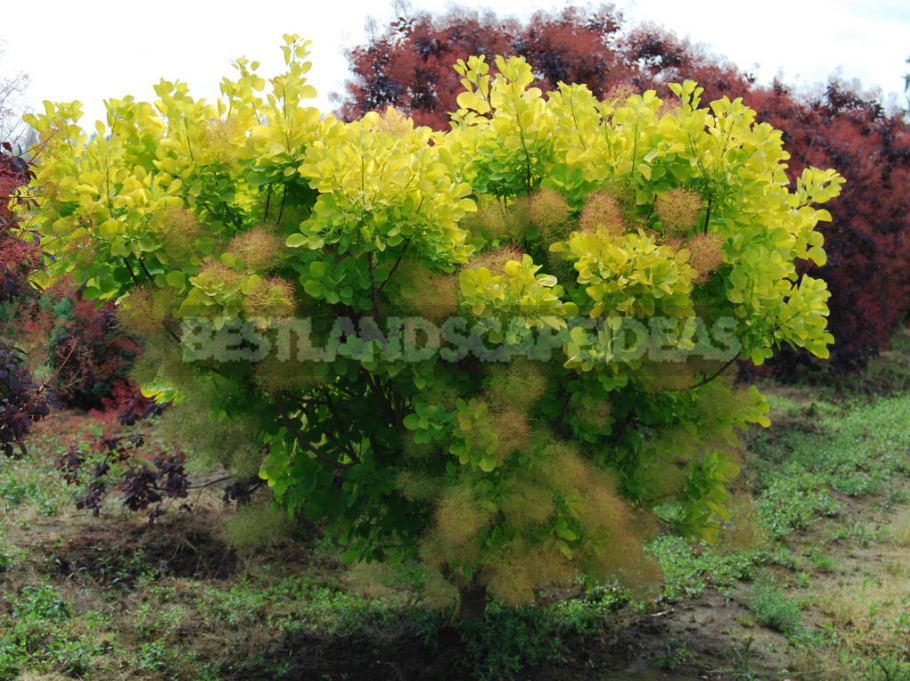
- ‘Velvet Cloak’
Shrub no more than 2 m tall. Red-purple leaves until the autumn retain this color when their color is replaced by red. Air inflorescences have a pink tint.
- ‘Young Lady’
It’s a dwarf form that grows slowly. For 5-10 years, the shrub reaches 1-1. 5 m in height. Forms a neat and compact Bush. Frost-resistant variety, characterized by a very early and abundant flowering, forms a lush pink inflorescence. The leaves are green in summer with a slight blue tint, in autumn they are painted in the whole range of yellow, orange, red.
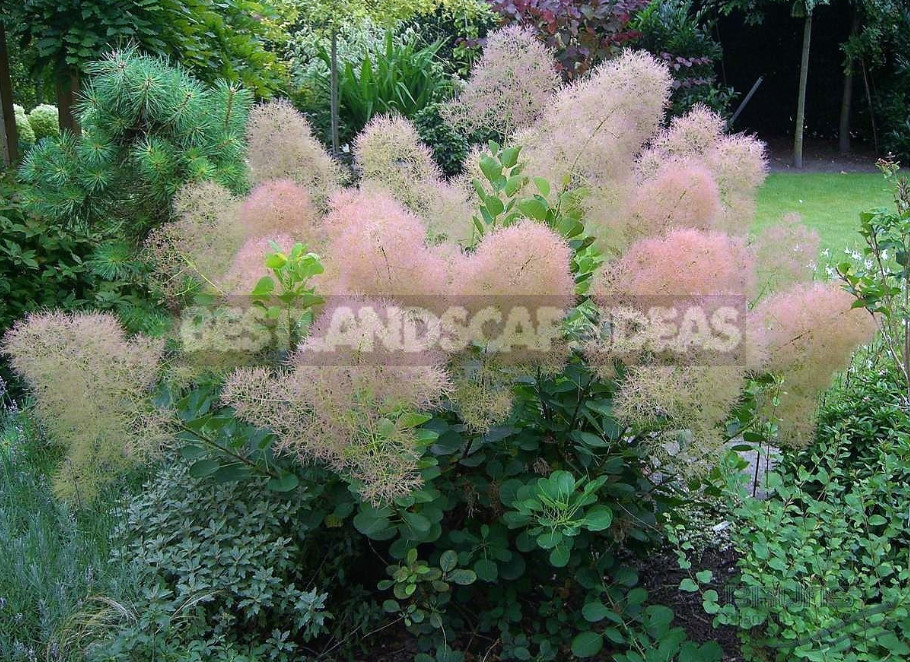
Cultivation
Grow Cotinus in the garden is not difficult. For it you need to choose the most illuminated and open area, it is better on a hill or slope-there it is the place. In no case should it be planted in the lowland or where groundwater is close. Cotinus easily tolerates drought, but does not like excessive moisture. The soil is ordinary garden, better more light and airy.
Landing
When choosing a place, remember that most cotinus varieties grow to the sides by 3-5 m. If the area is limited, look for selling plants more compact. Planting is carried out in spring and autumn, and seedlings grown in pots can be planted throughout the summer.
The pit is dug depending on the size of the root system of the young plant, it is very desirable to make lime. Fall asleep roots land with the addition of organic matter-compost or humus, although Cotinus can grow on a fairly poor land.

Maintenance
Early in the spring, immediately after the snow Cotinus is very useful to feed a complex mineral fertilizer. This will help the plant to regain strength and grow faster after the winter. In June, it is also worth to feed the tree, but now organic, for example, cow or bird droppings. Further Cotinus not require fertilization.
Watering should only recently planted plants and in the case of prolonged drought – then watering is necessary about once a week. Adult Cotinus do not need watering even in dry summer.
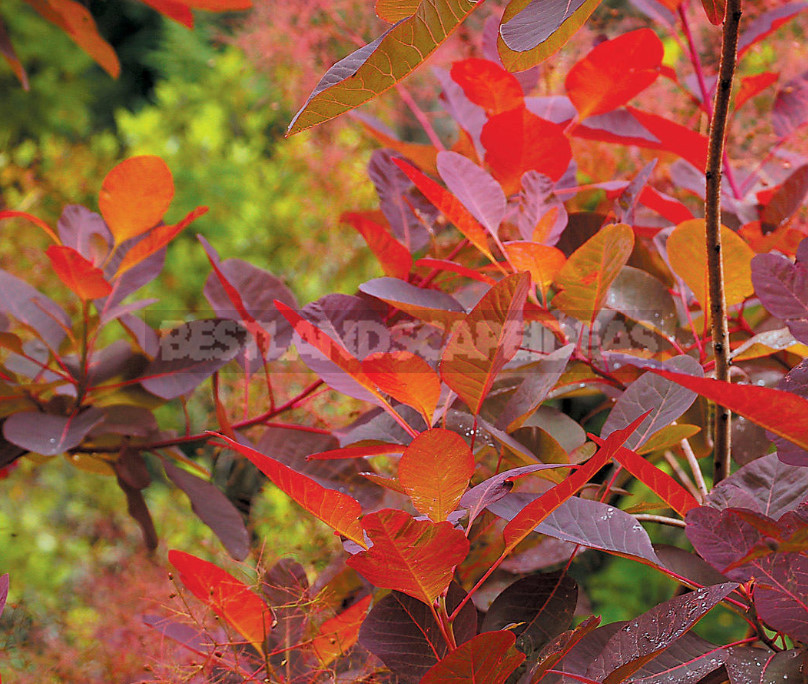
In the first time after planting Cotinus should be regularly cut. This contributes to the rapid and abundant growth of branches, and the leaves become larger. In the future, to get involved in pruning is not necessary, so as not to reduce the decorative flowering.
Sometimes Cotinus can be subjected to fungal diseases, which primarily affect the leaves – they begin to wither, shoots die. With this scourge should immediately cut off the affected parts of the plant.
Reproduction
Cotinus coggygria can be propagated by seed. Varietal plants is preferably dilute vegetative cuttings, layering and division of the bushes. It should also be borne in mind that the plant gives abundant root shoots.
The easiest way is to bend the lower branches and fix them with studs, sprinkled with earth. In places of contact of the shoots with earth’s crust should be slightly undercut – this will speed up the emergence of roots. After rooting, the branch is cut off from the parent plant, and the next year the seedling is transplanted to a permanent place.
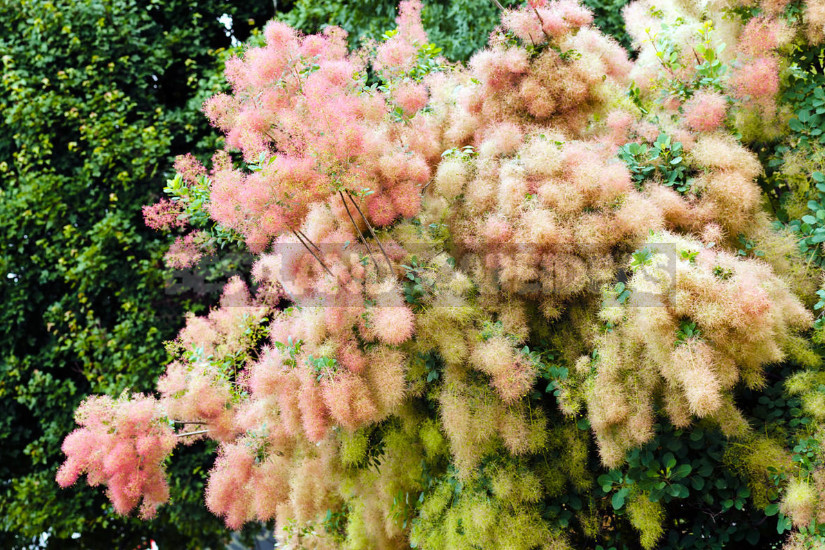
Propagated Cotinus and green cuttings, which are cut and soaked in a root stimulator for 12 hours. Then planted in a cold greenhouse with wet loose soil or in the cuttings, which is necessarily covered with lutrasil.
To rooting was successful, you need to spray the cuttings as often as possible, and the soil is kept constantly wet. Species Cotinus propagated by seeds, which are harvested in August. Sowing is carried out next spring.
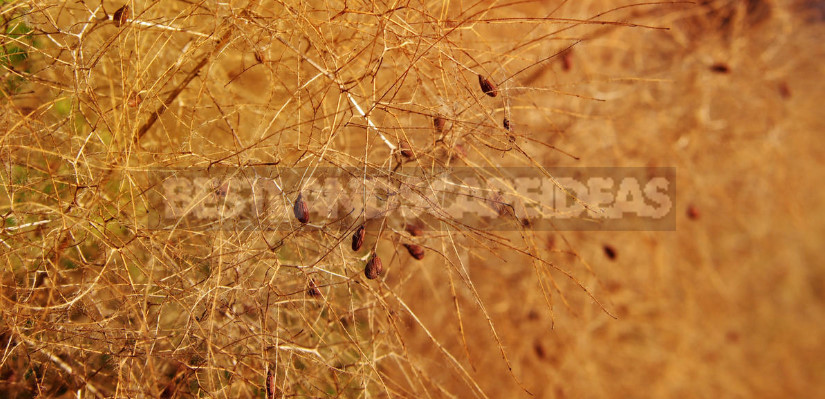
Application
Cotinus also has a certain economic value. In her shoots and leaves contain a dye of fisetin, which is used to give the fabrics and the skin of yellow and orange.
The plant is soft and light, but at the same time very durable wood, it can be used for the production of decorative wooden products and even musical instruments. Also, all parts of the plant are used in folk medicine for the preparation of infusions. They are mainly used externally for inflammation and skin diseases
Smoke tree as a garden decoration
But the main advantage of Cotinus is its incredible attractiveness. The plant will be a great decoration of the garden. Especially decorative varietal forms with colorful foliage, shrouded in a haze of air, like clouds of inflorescences – they will make your garden a unique flavor. Very good to be Cotinus in a single landing on a green lawn background, as well as in conjunction with coniferous and other ornamental shrubs.
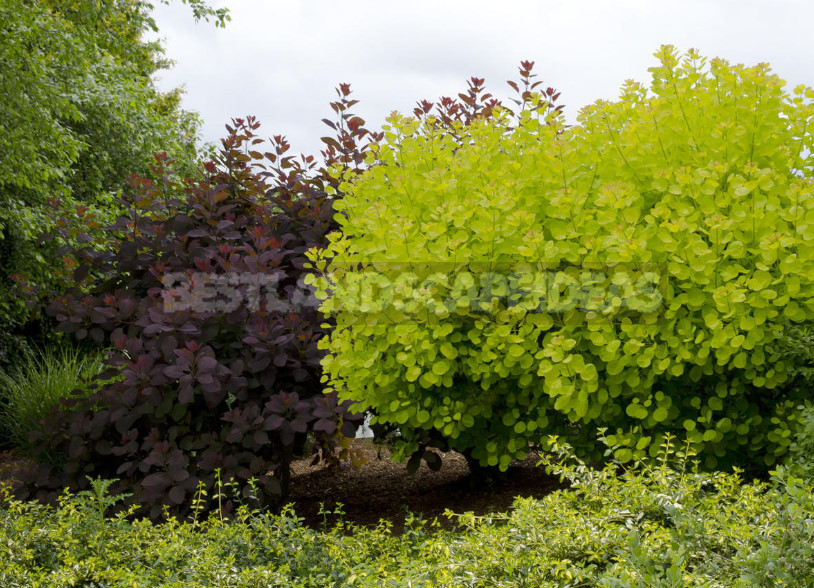
The main thing is that they do not obscure Cotinus. On a large area of this plant can be used to secure the slopes, it will be appropriate in a large rocky garden or rockery. Plant this magnificent shrub, it will undoubtedly decorate and diversify the look of your garden.
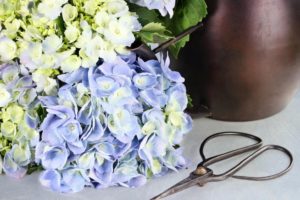
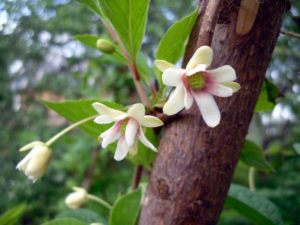
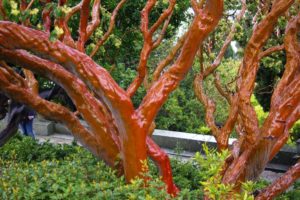
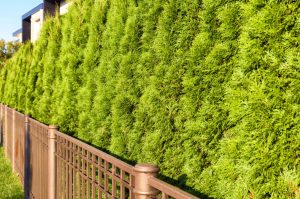
Leave a Reply